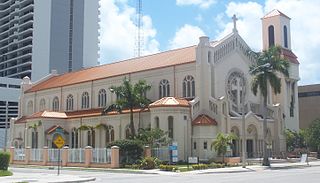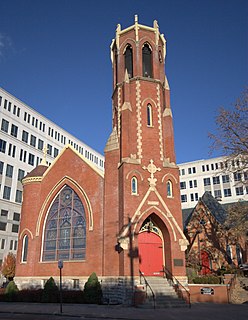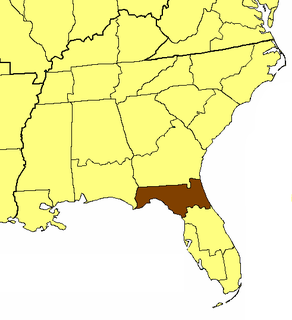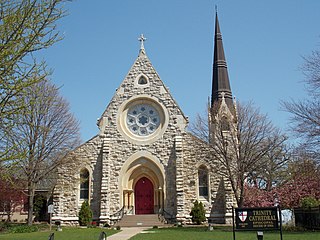"Christ Episcopal Church" may refer to the following similarly named churches or parishes in the United States:

St. James House of Prayer Episcopal Church, also known as the Episcopal House of Prayer, is an active Episcopal parish and historic church building in Tampa, Florida, United States. It is located at 2708 Central Avenue in the city's Tampa Heights neighborhood. On February 21, 1991, the building was added to the U.S. National Register of Historic Places. The structure is also included as an official contributing property within the Tampa Heights Historic District, which was declared a Historic District nationally by the United States Department of the Interior on August 4, 1995, and locally by the city of Tampa on September 7, 2000. Additionally, the building is one of only two churches to have been designated a Local Landmark Structure by the city of Tampa.

Trinity Episcopal Cathedral in Miami, Florida is the cathedral church of the Episcopal Diocese of Southeast Florida. It is located at North Bayshore Drive and the Venetian Causeway near the Carnival Center in Miami. On October 10, 1980, it was added to the U.S. National Register of Historic Places.

The former St. Andrew's Episcopal Church building, also known as Old St. Andrew's Event Venue, is an historic building located at 317 Florida Avenue in downtown Jacksonville, Florida. It was originally an Episcopal church, but closed when the parish relocated to the suburbs in 1960. On May 4, 1976, the edifice was added to the U.S. National Register of Historic Places. In the 1990s it was purchased by the City of Jacksonville and turned over to the Jacksonville Historical Society (JHS), and now serves as an event venue managed by the society.

Trinity Episcopal Church is located in Covington, Kentucky, Madison Avenue. This historic church was founded November 24, 1842, in a third floor of a brick building near the Covington market. The cornerstone of the first church was June 24, 1843 and the first service was on June 30, 1844. The church has served the people of Covington and Cincinnati, Ohio through wars and floods. The church is active today, with a large congregation at its Fourth and Madison Avenue location. The Rev. Peter D'Angio is the Rector and the Rev. Justin Gabbard is the associate Rector. It is the second largest parish in the Episcopal Diocese of Lexington.

The Episcopal Diocese of Florida is a diocese of the Episcopal Church in the United States of America (ECUSA). It originally comprised the whole state of Florida, but is now bounded on the west by the Apalachicola River, on the north by the Georgia state line, on the east by the Atlantic Ocean and on the south by the northern boundaries of Volusia, Marion, and Citrus counties. Its cathedral church is St. John's Cathedral in Jacksonville.

S. Stephen's Church is an historic Episcopal church located at 114 George Street in the College Hill neighborhood of Providence, Rhode Island. Located in the midst of the Brown University campus, it is an active parish in the Episcopal Diocese of Rhode Island, with a strong Anglo-Catholic identity.

St. Andrew's Episcopal Chapel is an historic Episcopal church located at 576 Fairmont Street in Woonsocket, Rhode Island.

St. Paul's Parish Church is a historic, Gothic Revival Episcopal church designed by architect Ralph Adams Cram. It is located at 26 Washington Street in Malden, Massachusetts and was built in 1913. The current building replaced an earlier 1871 building that now serves as the church's parish house. Some of the church's stained glass windows were created by the noted glass studio of Wilbur Herbert Burnham. The church was listed on the National Register of Historic Places in 2001. Its current minister is the Rev. John Clarke.

St. Mark's Episcopal Church is an historic Episcopal church building at Zero Freeland Street in Worcester, Massachusetts. The Romanesque Revival stone building was designed by local architect Stephen C. Earle, and built in 1888 for a congregation established the preceding year. On March 5, 1980, the church building was added to the National Register of Historic Places as St. Marks. The current priest is the Rev. Robert Carroll Walters.

St. Mary's Episcopal Church is a parish of the Episcopal Church, noted for its historic church at 14–16 Cushing Avenue in the Dorchester neighborhood of Boston, Massachusetts. Founded in 1847, it remains an active congregation of the Episcopal Diocese of Massachusetts.

Trinity Episcopal Cathedral, formerly known as Grace Cathedral, is the historic cathedral in the Diocese of Iowa. The cathedral is located on the bluff overlooking Downtown Davenport, Iowa, United States. Completed in 1873, Trinity is one of the oldest cathedrals in the Episcopal Church in the United States. It was individually listed on the National Register of Historic Places in 1974. In 1983 the cathedral was included as a contributing property in the College Square Historic District, which is also listed on the National Register.

St. Andrew's Episcopal Church is located at North Main and Madison avenues in Albany, New York, United States. It is a complex of three buildings, centered on the church itself, a stone structure designed by architect Norman Sturgis in the Late Gothic Revival architectural style and built in 1930. In 2005 it was listed on the National Register of Historic Places.

St. Andrew's Episcopal Church, is an Anglo-catholic church in Denver, Colorado. Its building, "considered by many people to be one of Denver's most beautiful churches" is a Gothic style church built c.1907-1909 that was designed by architect Ralph Adams Cram. It was dedicated January 17, 1909 as Trinity Memorial Church and renamed to St. Andrews in 1917.

St. John Chrysostom Church, also known as the Episcopal Church of St. John Chrysostom and the Little Red Church on the Hill, is a wooden Episcopal church built in 1852 in Delafield, Waukesha County, Wisconsin. In 1972 it was listed on the National Register of Historic Places.

Francis J. Kennard was a prolific architect of many prominent buildings in Tampa, Florida. The public buildings he designed are often in the Neoclassical style. His work includes Hillsborough High School, St. Andrews Episcopal Church, and the Belleview-Biltmore Hotel. Kennard employed the French Renaissance Revival style in his design for el Centro Español de Tampa as well as influences from Moorish Revival and Spanish Mediterranean Revival.

St. Luke's Episcopal Church is a parish of the Episcopal Church located in Hot Springs, Arkansas, in the Diocese of Arkansas. The congregation was established in 1866; its present interim Priest is Fr. Darrell Stayton.

The Cathedral Church of St. Peter is an Episcopal cathedral in St. Petersburg, Florida, United States. It is the seat of the Diocese of Southwest Florida. It 2004 it was included as a contributing property in the Downtown St. Petersburg Historic District on the National Register of Historic Places.

St. Luke's Episcopal Church, formerly known as Hope Episcopal Church, is an historic church building located in Fort Madison, Iowa, United States. It is a parish church of the Episcopal Diocese of Iowa, and it is a contributing property in the Park-to-Park Residential Historic District listed on the National Register of Historic Places.

St. Andrew's Episcopal Church is located in Waverly, Iowa, United States. It is a parish church of the Episcopal Diocese of Iowa. The church building is a contributing building and the bell tower is a contributing structure in the Sturdevant Southwest Historic District on the National Register of Historic Places.























